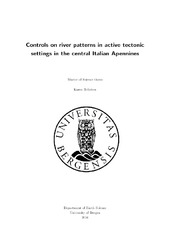Controls on river patterns in active tectonic settings in the central Italian Apennines
Master thesis
Permanent lenke
https://hdl.handle.net/1956/12571Utgivelsesdato
2016-05-31Metadata
Vis full innførselSamlinger
- Department of Earth Science [1050]
Sammendrag
The central Italian Apennines have gone through a complex evolutionary history, involving compression and subsidence, followed by extension and uplift. The last 3 Ma, the area has experienced active extension, and presently features a wide belt of parallel active normal faults. The configuration and evolution of the drainage network is largely controlled by activity along these faults, along with regional uplift. The central Apennines therefore represent an excellent site for studying the relations between fluvial geomorphology and tectonics. This study presents detailed data from two catchments in central Italy, containing highly active normal faults, one of which intersects the Paganica Fault that caused the devastating Mw 6.3 earthquake in 2009. This study aims to determine whether or not the studied streams are transiently responding to increasing slip rates on the faults they intersect, and if the two catchments might be interacting, with the overall goal of increasing our understanding of the landscape dynamics within the Abruzzo Region. Whether or not the study of fluvial geomorphology could aid in the prediction of high magnitude earthquake events, is also discussed. Data has been acquired through digital analyses by use of a high-resolution digital elevation model, and through detailed field work in the Abruzzo Region. Most of thse obtained data indicate a transient response for both streams, with some exceptions. The length-area- correlation turns out to be particularly interesting, as it provides linear plots with a Hack's constant that strongly indicates topographic steady state for both streams. This is discussed to be an indication that Hack's law is inadequate for determining whether or not a natural fluvial system is in equilibrium. Another possibility is that Hack's law is a delayed feature within the drainage systems, reflecting paleotopography, and the state of the catchments prior to faulting. Capturing events caused by aggressive headward erosion by streams intersecting active normal faults seems to be among the main processes in which the stream network is evolving within the field area. It is possibly the shaping mechanism for the studied catchments, and will likely be just as important for the future evolution of the drainage network within the central Italian Apennines.
